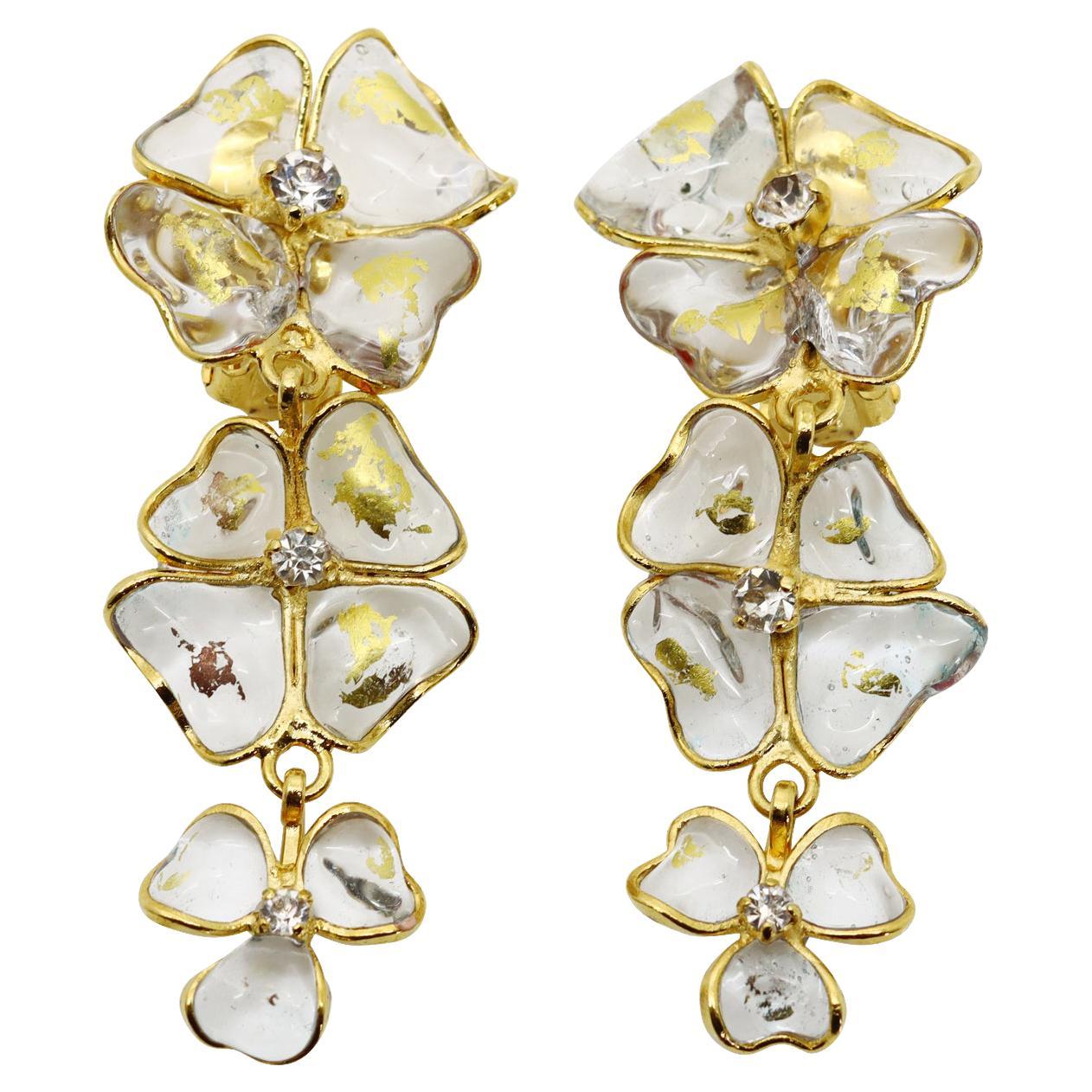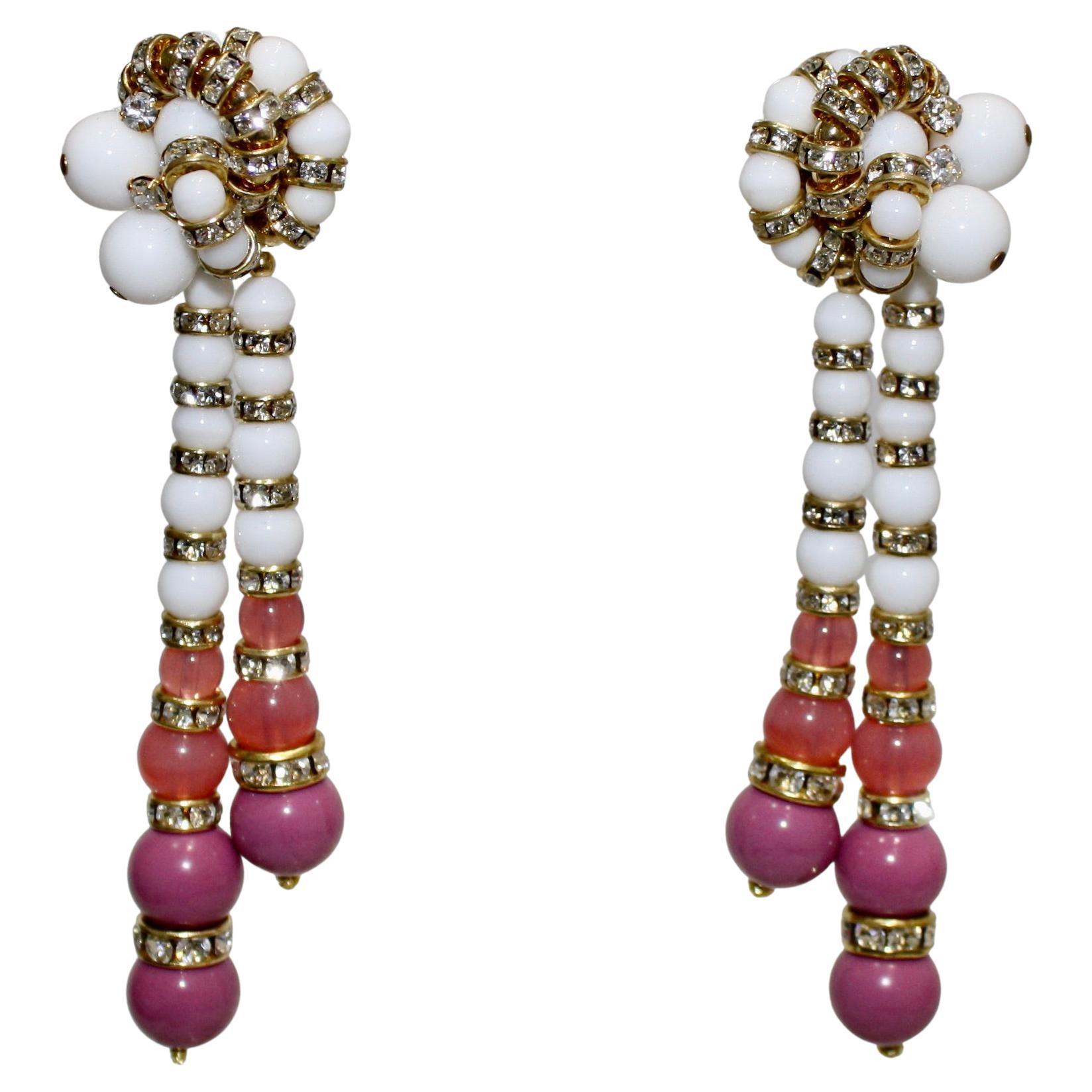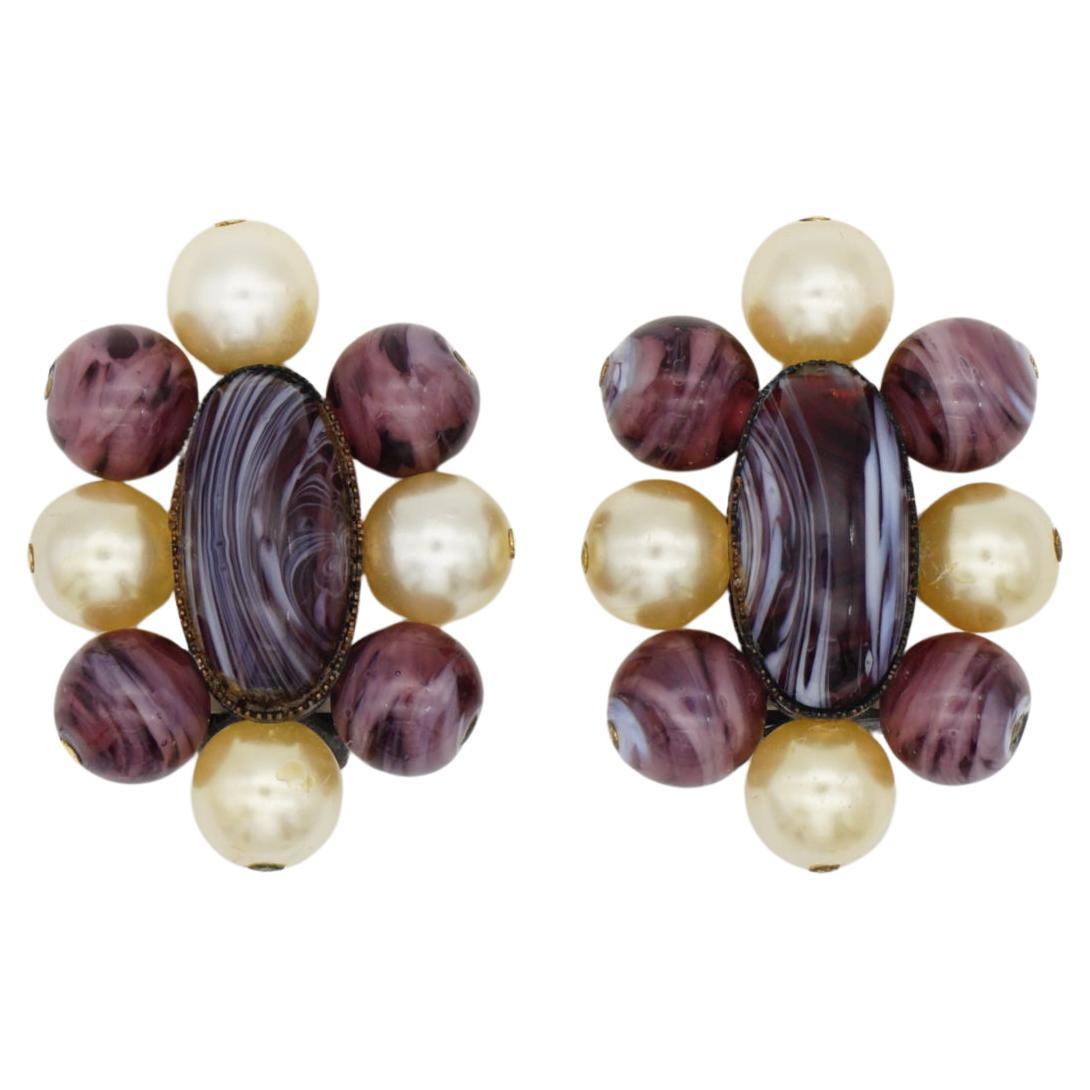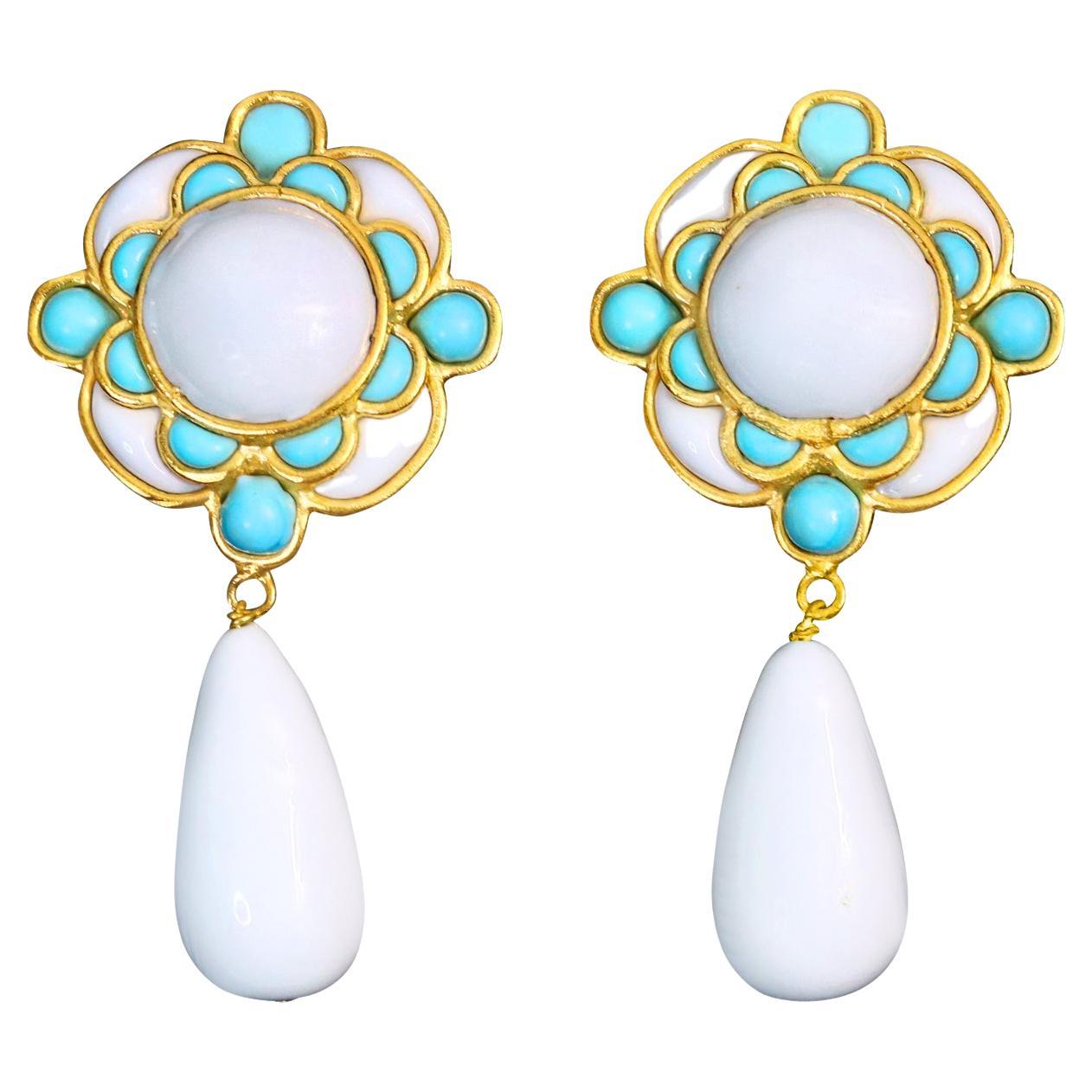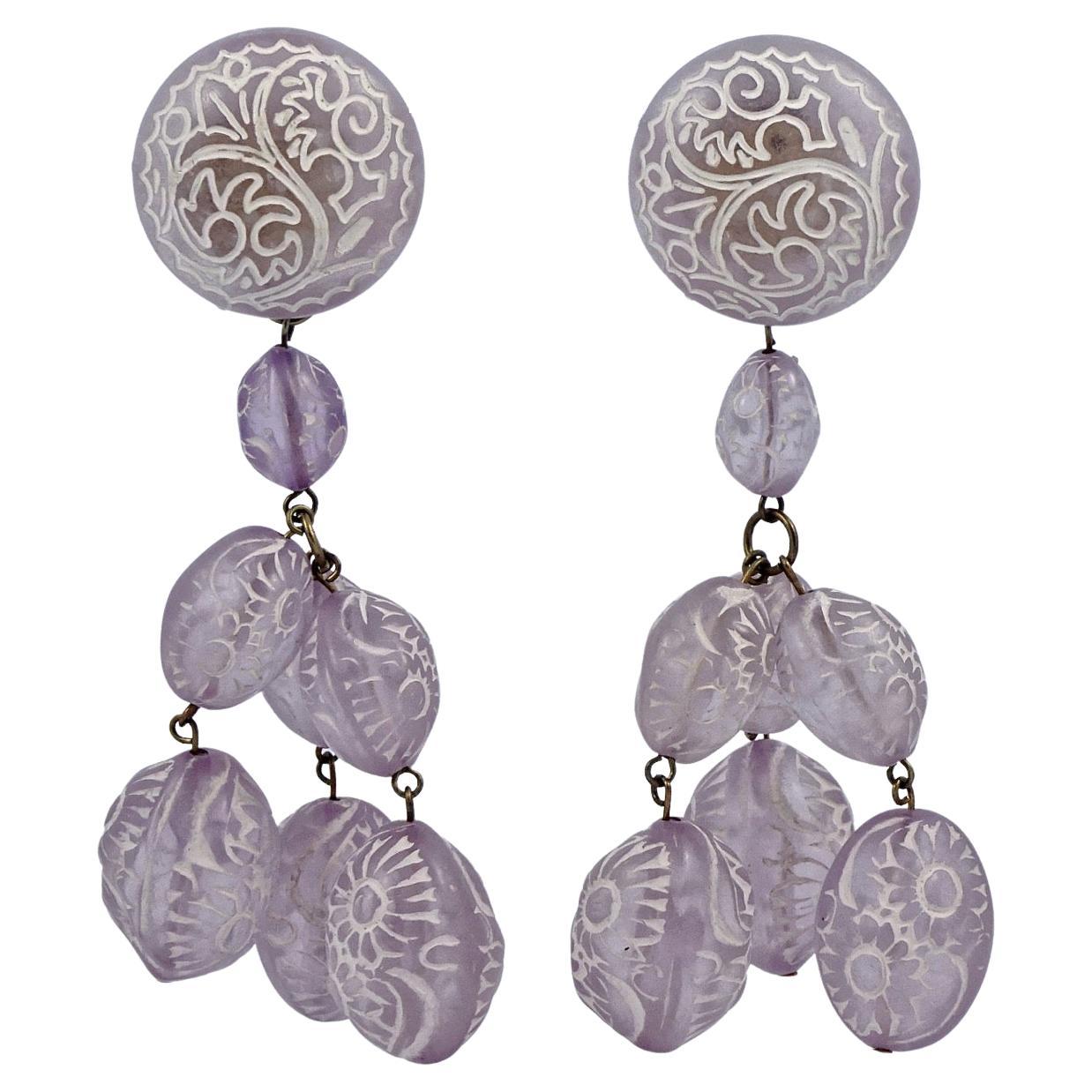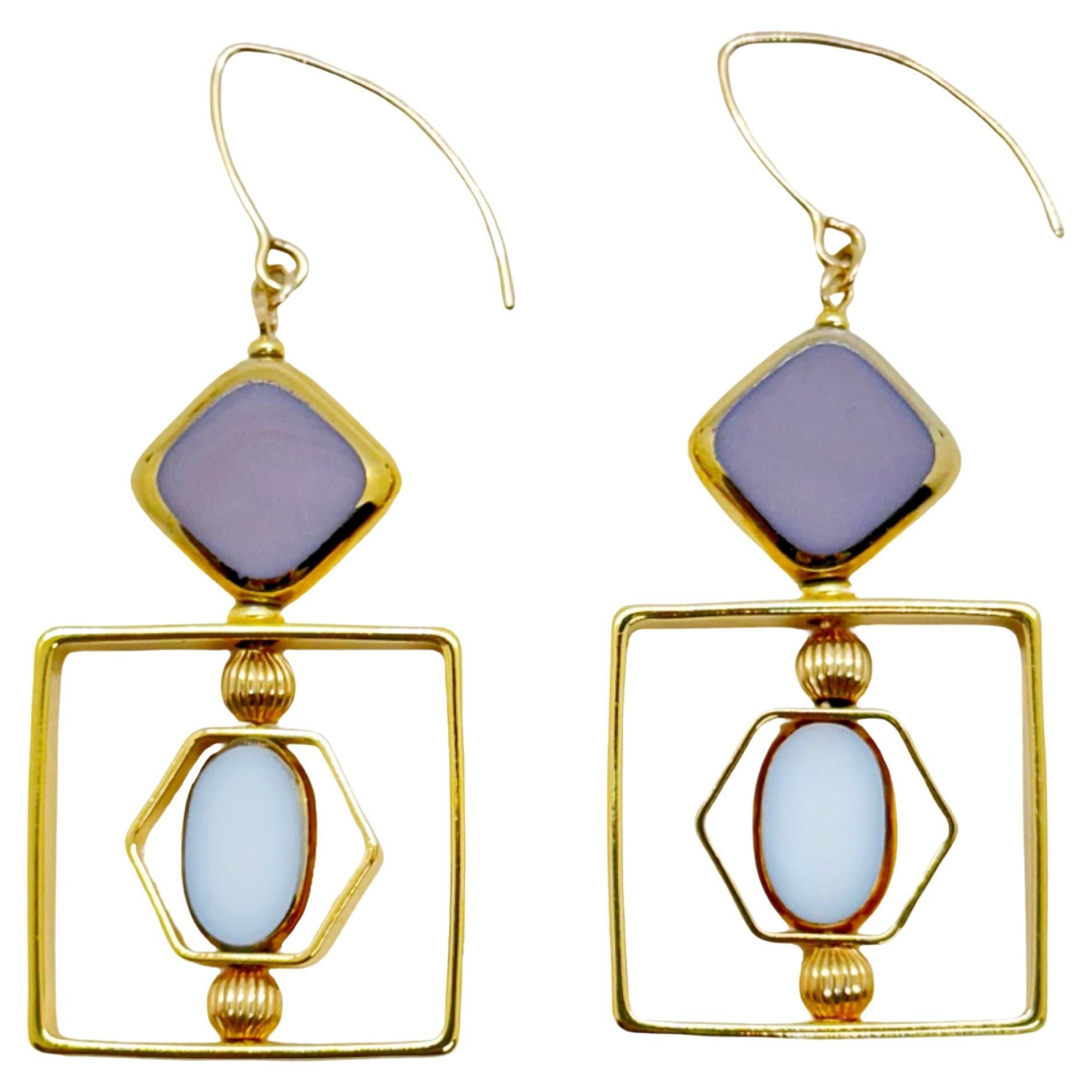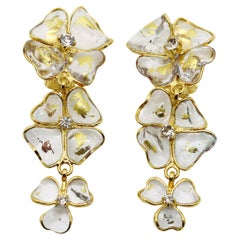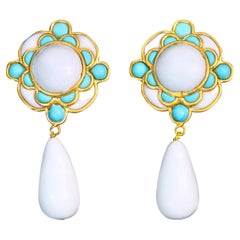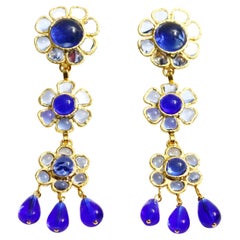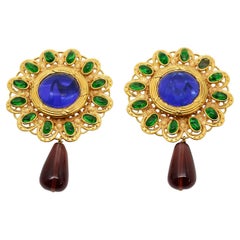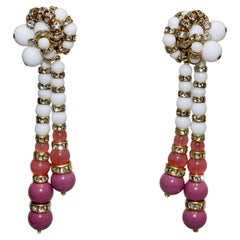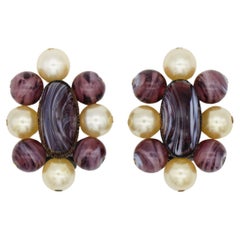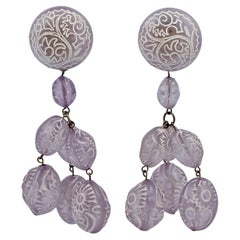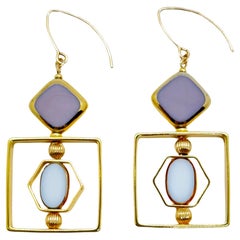Items Similar to Maison Gripoix Vintage White and Purple Dangling Earrings Circa 1980s
Video Loading
Want more images or videos?
Request additional images or videos from the seller
1 of 10
Maison Gripoix Vintage White and Purple Dangling Earrings Circa 1980s
$1,325
£1,019.28
€1,183.09
CA$1,868.57
A$2,093.11
CHF 1,099.38
MX$25,451.53
NOK 13,921.69
SEK 13,215.43
DKK 8,829.88
About the Item
Maison Gripoix Vintage White and Light Purple Dangling Earrings. These will always be in style. The Chanel look has never left. It is classic and timeless, conveying a sense of class. It is an elevated look. No matter what you wear, these will look right. A Chanel suit or jeans and a white t-shirt with a blazer. You look stunning and done. These are all you need. Clip on. This look will always walk down the Chanel runway in one form or another.
I will send you Velcro dots to hold them on, and you can do cartwheels in these earrings. The models in Paris wear them, and you can quickly wear them for 20 hours. Please ask for them.
Guy de Maupassant wrote a famous story about a necklace. The story is about a young, pretty, intelligent, well-educated but poorly endowed bride who has to marry a petty official; thus, suffering from the limitations of living a life with a husband that lacked any exquisite qualities. One day, to entertain his dejected spouse, her husband receives an invitation to a ball and gives his wife the 400 francs he had saved for a hunting rifle so that she can order an appropriate dress.
However, when the dress is ready, it becomes clear that it is lacking jewelry, and it would be impossible to attend the ball while looking so poor. The protagonist approaches her wealthy childhood friend, with whom she was raised at the monastery, and borrows a diamond necklace from her. The ball is a great success, and she is the centre of attention. However, when the woman returns home, she discovers that she has lost the necklace. To conceal her faux pas from her friend, she buys a new necklace identical to the one she lost. To pay it off, the woman gets into a huge debt, which, over the years, gradually drags her down the social ladder from the bourgeoisie to poverty. Ten years later, having lost her good looks, the woman encounters her friend on the Champs Elysees, who still looks young, beautiful, and rich. The protagonist reveals to her friend the entire story about the necklace, but her friend replies in amazement that the diamonds were fake and would “cost 500 francs at most.”
Maison Gripoix starts out with a dramatic story. In 1869 (or a year earlier, according to other sources), Paris master glassmaker Augustina Gripoix began creating replicas of pearls and crystals, casting glass into various shapes and colors and inserting them into the most sophisticated settings. She used the pâte de verre (glass paste) technique, whereby a traditional ceramic or gypsum form was filled with a multi-colour piece of glass and special gluing substances and then baked in a furnace, resulting in objects featuring fantastical hues. Only Augustina made her crystals by pouring the melted glass paste into the press moulds, skipping the furnace step, allowing her to achieve the purity of colour, transparency, and shine. She found a simple method to create beautiful jewelry, and thus, Marquises, Duchesses, and Princesses queued up. Madame Gripoix would then create replicas of their own jewelry in case of robbery or loss, or unusual pieces for their new wraps, neckpieces, or boas. The so-called ‘costume jewelry’ emerged to a large extent thanks to the work of Maison Gripoix.
Augustina Gripoix earned her fame in the 1890s when she began creating necklaces for Sarah Bernhardt to wear on stage and later designed costume jewelry for the first high fashion house of Charles Frederick Worth. Later on, Paul Poiret, the leading couturier of 1910, contacted her, and she created sophisticated Oriental-style jewelry for him to match his famous Oriental costumes, based on the aesthetic of Diaghilev’s initial Russian seasons.
The value of costume jewelry was now being recognized in its own right and not just for imitation purposes. The taste of emancipated young girls, who were gaining more and more freedom and opportunities, was best met with bijouterie. So in the 1920s, when Augustina’s daughter Susan became the head of the House, Gripoix prospects became even more exciting. Girls with short-cropped hair in short dresses zoomed by in open-top cars wearing bijou rather than diamonds. Everyone ordered bijouterie from Madam Gripoix during this period, from Jeanne Lanvin to Jean Piguet; however, the best relationship Gripoix had was with Gabrielle Chanel.
It is well-known that Chanel, a fan of large jewelry with large stones, made bijouterie super fashionable. Chanel brought copies of Byzantine jewelry to Susanne Gripoix. She asked her to create the pieces in that same style, requesting, “Let everyone think that this jewelry is not new, but found somewhere on an excavation site nearby Rue Camborne.” She was so satisfied with the result of her order that she remained a faithful client of Gripoix for several decades. This was how the famous byzantine style of Chanel jewelry was brought to life, fancying golden Maltese crosses with large multicolor stones and matching bracelets, cabochons, and massive brooches, all of which have become a part of the Gripoix
Chanel liked to combine both natural and imitation stones in a single item; for example, she would pair natural and imitation pearls in a single necklace. Gripoix made them in such a way that it was impossible to distinguish between them. Susanne Gripoix created unique, irregularly shaped glass pearls for Chanel, imitating baroque pearls. They were enameled in her workshops with mother-of-pearl to obtain some of the soft shine characteristic of natural pearls
.
As the leading supplier to the couturier houses in Paris, Gripoix collaborated with many renowned designers, including Cristóbal Balenciaga, Pierre Balmain, and Christian Dior, as well as Yves Saint Laurent and, later, Christian Lacroix and Marc Jacobs. However, it was the cooperation with Chanel that was the most significant, both for Chanel and for Gripoix.
Today, Gripoix is no longer a family-owned company, but the House still crafts jewelry, although the style has undergone considerable changes over the last few years. The jewelry has become more straightforward, more graphical, and even minimalistic. In 2011, however, Gripoix and Catherine Baba, a well-known Paris stylist and the star of street-style blogs, released a joint collection in the style of Art Nouveau and neo-romanticism. Even today, Gripoix tries to preserve the traditional techniques of moulding and enameling. They use a special copper alloy supplied by the Art Metal Company, which is as old as Gripoix, and the formula for this alloy is kept secret. After it's melted, dragged and screwed in various ways, it is made into moulds that are welded using brass powder, a technique rarely found elsewhere today, before being gold-plated in the neighbouring workshop. Historical jewelry made by Gripoix, especially pieces created for Chanel, are objects of genuine cult value. They are collected, they are hunted down, they are sold at auction, and their prices have recently skyrocketed.
- Creator:
- Metal:
- Weight:66.2 g
- Dimensions:Height: 3 in (76.2 mm)Width: 1.5 in (38.1 mm)Depth: 0.1 in (2.54 mm)Diameter: 1.5 in (38.1 mm)Length: 3 in (76.2 mm)
- Style:
- Place of Origin:
- Period:
- Date of Manufacture:1980
- Condition:Wear consistent with age and use. Excellent Condition!
- Seller Location:New York, NY
- Reference Number:Seller: E16-051stDibs: LU2565214956692
About the Seller
5.0
Recognized Seller
These prestigious sellers are industry leaders and represent the highest echelon for item quality and design.
Gold Seller
Premium sellers maintaining a 4.3+ rating and 24-hour response times
Established in 2014
1stDibs seller since 2022
215 sales on 1stDibs
Typical response time: <1 hour
- ShippingRetrieving quote...Shipping from: New York, NY
- Return Policy
Authenticity Guarantee
In the unlikely event there’s an issue with an item’s authenticity, contact us within 1 year for a full refund. DetailsMoney-Back Guarantee
If your item is not as described, is damaged in transit, or does not arrive, contact us within 7 days for a full refund. Details24-Hour Cancellation
You have a 24-hour grace period in which to reconsider your purchase, with no questions asked.Vetted Professional Sellers
Our world-class sellers must adhere to strict standards for service and quality, maintaining the integrity of our listings.Price-Match Guarantee
If you find that a seller listed the same item for a lower price elsewhere, we’ll match it.Trusted Global Delivery
Our best-in-class carrier network provides specialized shipping options worldwide, including custom delivery.More From This Seller
View AllVintage Gripoix Translucent Pate De Verre Earrings Circa 1980s
By Maison Gripoix
Located in New York, NY
Vintage Gripoix Translucent Earrings with Pieces Of Gold. Dangling Earrings With Pieces of Gold and Stones. Long Necklace/Sautoir on Site to Match. So Gorgeous! Clip On.
Guy de Maupassant wrote a famous story about a necklace. The story revolves around a young, attractive, and intelligent woman who struggles with the limitations of living with a husband who lacks exceptional qualities. One day, to entertain his dejected spouse, her husband receives an invitation to a ball and gives his wife the 400 francs he had saved for a hunting rifle so that she can order an appropriate dress.
However, when the dress is ready, it becomes clear that it is lacking jewelry, and it would be impossible to attend the ball while looking so poor. The protagonist approaches her wealthy childhood friend, with whom she was raised at the monastery, and borrows a diamond necklace from her. The ball is a great success, and she is the centre of attention. However, when the woman returns home, she discovers that she has lost the necklace. To conceal her faux pas from her friend, she buys a new necklace identical to the one she lost. To pay it off, the woman becomes mired in massive debt, which, over the years, gradually drags her down the social ladder from the bourgeoisie to poverty. Ten years later, having lost her good looks, the woman encounters her friend on the Champs-Élysées, who still looks young, beautiful, and rich. The protagonist reveals to her friend the entire story about the necklace, but her friend replies in amazement that the diamonds were fake and would “cost 500 francs at most.”
Maison Gripoix starts with a dramatic story. In 1869 (or a year earlier, according to other sources), Paris master glassmaker Augustina Gripoix began making replicas of pearls and crystals, casting glass into various shapes and colors and inserting them into the most sophisticated settings. She used the pâte de verre (glass paste) technique, whereby a traditional ceramic or gypsum form was filled with a multi-colour piece of glass and special gluing substances and then baked in a furnace, resulting in objects featuring fantastical hues. Only Augustina made her crystals by pouring the melted glass paste into the press moulds, skipping the furnace step, allowing her to achieve the purity of colour, transparency, and shine. She found a simple method to make beautiful jewelry and thus Marquises, Duchesses, and Princesses queued up ... so Madame Gripoix would make them replicas of their jewelry in case of robbery or loss, or some unusual jewelry pieces for their new wraps, neckpieces, or boas. The so-called ‘costume jewelry’ emerged to a large extent thanks to the work of Maison Gripoix.
Augustina Gripoix earned her fame in the 1890s when she began creating necklaces for Sarah Bernhardt to wear on stage and later designed costume jewelry for the first high-fashion house, founded by Charles Frederick Worth. Later, Paul Poiret, the leading couturier of 1910, contacted her, and she created sophisticated Oriental-style jewelry for him to match his famous Oriental costumes, based on the aesthetic of Diaghilev’s initial Russian seasons.
The value of costume jewelry was now being recognized in its own right and not just for imitation purposes. The taste of emancipated young girls, who were gaining more and more freedom and opportunities, was best met with bijouterie. So in the 1920s, when Augustina’s daughter Susan became the head of the House, Gripoix prospects became even more exciting. Girls with short-cropped hair in short dresses zoomed by in open-top cars wearing bijou rather than diamonds. Everyone ordered bijouterie from Madam Gripoix during this period, from Jeanne Lanvin to Jean Piguet...
Category
Vintage 1980s French Modern Dangle Earrings
Materials
Mixed Metal
Vintage Maison Gripoix Faux Turquoise and White Dangling Earrings Circa 1980s
By Maison Gripoix
Located in New York, NY
Maison Gripoix Vintage Faux Turquoise and White Layered Dangling Earrings. There are three layers to this, all wrapped in an offset gold tone and then a long, dangling piece. These are so stunning and look good with many colors. Clip On. These are proper statement earrings in that they are so well-made. These can also be worn in the winter against dark colors.
Guy de Maupassant wrote a famous story about a necklace. The story is about a young, attractive, intelligent, well-educated, but under-endowed bride who must marry a petty official and thus suffers from the limitations of living with a husband who lacks refined qualities. One day, to entertain his dejected spouse, her husband receives an invitation to a ball and gives his wife the 400 francs he had saved for a hunting rifle so that she can order an appropriate dress.
However, when the dress is ready, it becomes clear that it is lacking jewelry, and it would be impossible to attend the ball while looking so poor. The protagonist approaches her wealthy childhood friend, with whom she was raised at the monastery, and borrows a diamond necklace from her. The ball is a great success; she is the center of attention. However, when the woman returns home, she discovers she has lost the necklace. To conceal her faux pas from her friend, she buys a new necklace identical to the one she lost. To pay it off, the woman gets into a huge debt, which, over the years, gradually drags her down the social ladder from the bourgeoisie to poverty. Ten years later, having lost her good looks, the woman encounters her friend on the Champs Elysees, who still looks young, beautiful, and rich. The protagonist reveals the entire story about the necklace to her friend, but her friend replies in amazement that the diamonds are fake and would “cost 500 francs at most.”
Maison Gripoix starts with a dramatic story. According to other sources, in 1869 (or a year earlier), Paris master glass-maker Augustina Gripoix began making replicas of pearls and crystals, casting glass into different shapes and colors and inserting them into the most sophisticated settings. She used the pâte de verre (glass paste) technique, whereby a traditional ceramic or gypsum form was filled with a multi-color piece of glass and special gluing substances and then baked in a furnace, resulting in objects featuring fantastical hues. Only Augustina made her crystals by pouring the melted glass paste into the press molds, skipping the furnace step, allowing her to achieve purity of color, transparency, and shine. She found a simple method to make beautiful jewelry, and thus Marquises, Duchesses, and Princesses qued up ... so Madame Gripoix would make them replicas of their jewelry in case of robbery or loss, or some unusual jewelry pieces for their new wraps, neckpieces, or boas. The so-called ‘costume jewelry’ emerged to a large extent thanks to the work of Maison Gripoix.
Augustina Gripoix earned her fame in the 1890s when she began creating necklaces for Sarah Bernhardt to wear on stage and later designed costume jewelry for Charles Frederick Worth's first high-fashion house. Later, Paul Poiret, the leading couturier of the 1910s, contacted her, and she created sophisticated, Oriental-style jewelry to match his famous Oriental costumes, based on the aesthetic of Diaghilev’s initial Russian seasons.
The value of costume jewelry was now being recognized in its own right and not just for imitation purposes. The taste of emancipated young girls, who were gaining more and more freedom and opportunities, was best met with bijouterie. So in 1920, when Augustina’s daughter Susan became the head of the House, Gripoix's prospects became even more exciting—girls with short-cropped hair in short dresses zoomed by in open-top cars wearing bijou rather than diamonds. Everyone ordered bijouterie from Madam Gripoix during this period, from Jeanne Lanvin to Jean Piguet...
Category
Vintage 1980s French Modern Dangle Earrings
Materials
Mixed Metal
Maison Gripoix Vintage Blue and Light Blue Flower Dangling Earrings Circa 1980s
By Maison Gripoix
Located in New York, NY
Maison Gripoix Vintage Blue and Light Blue Flower Dangling Earrings Set in Gold Tone Clip On. Always In Style. Very Classic Chic. These are so spectacular. I have them in red as well. The prices differ because they were purchased at different exchange rates. These are stunning. They will never go out of style!!
Guy de Maupassant wrote a famous story about a necklace. The story is about a young, attractive, intelligent, well-educated, but under-endowed bride who must marry a petty official and thus suffers from the limitations of living with a husband who lacks refined qualities. One day, to entertain his dejected spouse, her husband receives an invitation to a ball and gives his wife the 400 francs he had saved for a hunting rifle, so that she can order an appropriate dress.
However, when the dress is ready, it becomes clear that it is lacking jewelry, and it would be impossible to attend the ball while looking so poor. The protagonist approaches her wealthy childhood friend, with whom she was raised at the monastery, and borrows a diamond necklace from her. The ball is a great success; she is the center of attention. However, when the woman returns home, she discovers she has lost the necklace. To conceal her faux pas from her friend, she buys a new necklace identical to the one she lost. To pay it off, the woman gets into a huge debt, which, over the years, gradually drags her down the social ladder from the bourgeoisie to poverty. Ten years later, having lost her good looks, the woman encounters her friend on the Champs Elysees, who still looks young, beautiful, and rich. The protagonist reveals the entire story about the necklace to her friend, but her friend replies in amazement that the diamonds are fake and would “cost 500 francs at most.”
Maison Gripoix starts with a dramatic story. According to other sources, in 1869 (or a year earlier), Paris master glass-maker Augustina Gripoix began making replicas of pearls and crystals, casting glass into different shapes and colors and inserting them into the most sophisticated settings. She used the pâte de verre (glass paste) technique, whereby a traditional ceramic or gypsum form was filled with a multi-color piece of glass and special gluing substances and then baked in a furnace, resulting in objects featuring fantastical hues. Only Augustina made her crystals by pouring the melted glass paste into the press molds, skipping the furnace step, allowing her to achieve purity of color, transparency, and shine. She found a simple method to make beautiful jewelry, and thus Marquises, Duchesses, and Princesses qued up ... so Madame Gripoix would make them replicas of their jewelry in case of robbery or loss, or some unusual jewelry pieces for their new wraps, neckpieces, or boas. The so-called ‘costume jewelry’ emerged to a large extent thanks to the work of Maison Gripoix.
Augustina Gripoix earned her fame in the 1890s when she began creating necklaces for Sarah Bernhardt to wear on stage and later designed costume jewelry for Charles Frederick Worth's first high-fashion house. Later, Paul Poiret, the leading couturier of the 1910s, contacted her, and she created sophisticated, Oriental-style jewelry to match his famous Oriental costumes, based on the aesthetic of Diaghilev’s initial Russian seasons.
The value of costume jewelry was now being recognized in its own right and not just for imitation purposes. The taste of emancipated young girls, who were gaining more and more freedom and opportunities, was best met with bijouterie. So in 1920, when Augustina’s daughter Susan became the head of the House, Gripoix's prospects became even more exciting—girls with short-cropped hair in short dresses zoomed by in open-top cars wearing bijou rather than diamonds. Everyone ordered bijouterie from Madam Gripoix during this period, from Jeanne Lanvin to Jean Piguet...
Category
Vintage 1980s French Modern Dangle Earrings
Materials
Mixed Metal
Maison Gripoix Vintage Blue, Green and Red Dangling Earrings Circa 1980s
By Maison Gripoix
Located in New York, NY
Maison Gripoix Vintage Blue, Green, and Red Dangling Earrings. These will always look classic and in style. This look never leaves the mood board....
Category
Vintage 1980s French Modern Drop Earrings
Materials
Mixed Metal
Maison Gripoix Vintage Faux Pearl and Red Dangling Earrings Circa 1980s
By Maison Gripoix
Located in New York, NY
Maison Gripoix Vintage Faux Pearl and Red Dangling Earrings. Wrapped in woven gold around the Pearl in the typical 1980s style of Chanel. Clip on. So classic, and you always look good no matter what you are wearing when you have these on. Clip on.
Very much the colors of Chanel.
Guy de Maupassant wrote a famous story about a necklace. The story is about a young, pretty, intelligent, well-educated but poorly endowed bride who has to marry a petty official; thus, suffering from the limitations of living a life with a husband that lacked any exquisite qualities. One day, to entertain his dejected spouse, her husband receives an invitation to a ball and gives his wife the 400 francs he had saved for a hunting rifle so that she can order an appropriate dress.
However, when the dress is ready, it becomes clear that it is lacking jewelry, and it would be impossible to attend the ball while looking so poor. The protagonist approaches her wealthy childhood friend, with whom she was raised at the monastery, and borrows a diamond necklace from her. The ball is a great success, and she is the centre of attention. However, when the woman returns home, she discovers that she has lost the necklace. To conceal her faux pas from her friend, she buys a new necklace identical to the one she lost. To pay it off, the woman gets into a huge debt, which, over the years, gradually drags her down the social ladder from the bourgeoisie to poverty. Ten years later, having lost her good looks, the woman encounters her friend on the Champs Elysees, who still looks young, beautiful, and rich. The protagonist reveals to her friend the entire story about the necklace, but her friend replies in amazement that the diamonds were fake and would “cost 500 francs at most.”
Maison Gripoix starts out with a dramatic story. In 1869 (or a year earlier, according to other sources), Paris master glassmaker Augustina Gripoix began creating replicas of pearls and crystals, casting glass into various shapes and colors and inserting them into the most sophisticated settings. She used the pâte de verre (glass paste) technique, whereby a traditional ceramic or gypsum form was filled with a multi-colour piece of glass and special gluing substances and then baked in a furnace, resulting in objects featuring fantastical hues. Only Augustina made her crystals by pouring the melted glass paste into the press moulds, skipping the furnace step, allowing her to achieve the purity of colour, transparency, and shine. She found a simple method to create beautiful jewelry, and thus, Marquises, Duchesses, and Princesses queued up. Madame Gripoix would then create replicas of their jewelry in case of robbery or loss or unusual pieces for their new wraps, neckpieces, or boas. The so-called ‘costume jewelry’ emerged to a large extent thanks to the work of Maison Gripoix.
Augustina Gripoix earned her fame in the 1890s when she began creating necklaces for Sarah Bernhardt to wear on stage and later designed costume jewelry for the first high fashion house of Charles Frederick Worth. Later, Paul Poiret, the leading couturier of 1910, contacted her, and she created sophisticated Oriental-style jewelry for him to match his famous Oriental costumes, based on the aesthetic of Diaghilev’s initial Russian seasons.
The value of costume jewelry was now being recognized in its own right and not just for imitation purposes. The taste of emancipated young girls, who were gaining more and more freedom and opportunities, was best met with bijouterie. So in the 1920s, when Augustina’s daughter Susan became the head of the House, Gripoix prospects became even more exciting. Girls with short-cropped hair in short dresses zoomed by in open-top cars wearing bijou rather than diamonds. Everyone ordered bijouterie from Madam Gripoix during this period, from Jeanne Lanvin to Jean Piguet...
Category
Vintage 1980s French Modern Dangle Earrings
Materials
Mixed Metal
Vintage Gold Pink Opalescent Stones with Grey Diamante Earrings Circa 1960s
Located in New York, NY
Vintage Gold Pink Opalescent Stones with Gray Diamante Earrings Circa 1960s. A beautiful pair of earrings with emerald and marquis cuts with a round shape of darker gray diamante on ...
Category
Vintage 1960s American Modern Clip-on Earrings
Materials
Mixed Metal
You May Also Like
Françoise Montague White and Rose Drop Earrings
By Francoise Montague
Located in Virginia Beach, VA
Clip earrings with a twisted design in white hand made cabochons and gold Swarovski crystal . 2 strands of the glass cabochons in white and rose glas...
Category
2010s French Modern Drop Earrings
Christian Dior 1960 Vintage Oval Ball Purple Marble Floral White Pearl Earrings
By Christian Dior
Located in Wokingham, England
Christian Dior 1960 Vintage Textured Oval Ball Round Circle Purple Marble Floral White Pearls Clip Earrings
Very good condition. Very rare to find. High value collection. 100% Genui...
Category
Vintage 1960s German Art Deco Clip-on Earrings
Materials
Gold Plate
Gold Tone Lilac and White Etched Glass Clip on Drop Earrings circa 1960s
Located in London, GB
Fabulous gold tone clip on earrings, featuring lovely lilac and white etched glass drops. Measuring length 10.2cm / 4 inches, and the top is diameter 2.9cm / 1.1 inch. The earrings a...
Category
Vintage 1960s Drop Earrings
White And Lavender Vintage German Glass Beads Art Deco 2409E Earrings
By Aracheli Studio
Located in Monrovia, CA
The earrings are lightweight and are made to rotate and reposition with movement.
The earrings consist of white and lavender new old stock vintage German glass beads that are framed...
Category
2010s American Art Deco Drop Earrings
Materials
Gold, 14k Gold, 24k Gold, Gold-filled, Gold Plate, Brass
Diamonds White Stones Leaves, Amethyst Drops and Sapphires Gold Earrings
Located in Marcianise, Marcianise (CE)
Charming drop earrings in 14K white gold, composed of white stones leaves at the top linked with diamonds, blue sapphires flowers and yellow sapphires in the center, and finally amet...
Category
Vintage 1970s Italian Retro Drop Earrings
Materials
Amethyst, Diamond, Yellow Sapphire, Blue Sapphire, Sapphire, 14k Gold, R...
Art Deco Style Amethyst Peridot Chalcedony Gold Diamonds Enamel Drop Earrings
By Tutti Frutti Jewellery
Located in Bangkok, TH
These earrings have a pair of 10 mm Amethyst buttons on the top from which are suspended 2 faceted oval Amethysts and elements in white gold , diamonds and green enamel, in the lower...
Category
2010s Thai Art Deco Drop Earrings
Materials
Peridot, Diamond, Chalcedony, Amethyst, Enamel, 18k Gold, Gold
More Ways To Browse
Vintage Purple Jewelry
Vintage Gripoix Jewelry
Gripoix Gold
Pearl Dangle Necklace
Purple Vintage Earrings
French Marquis
Dangly Ball Earrings
Dangle Screw Earrings
Purple Jeans
Large Dangle Pearl Earrings
Purple Pearls Earrings
Faux Pearl Dangle Earrings
Vintage Cross Earrings
Gripoix Poured Glass Maison
Chanel Purple Vintage
Cross Jewelry 1980s
Dior Stone Earrings
Yves Saint Laurent White Dress
